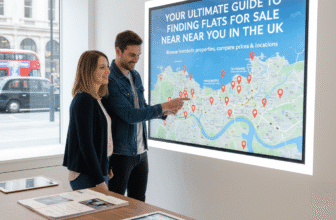
Unlocking Your Dream Home: The Ultimate Guide to Navigating Zoopla
The journey to finding a new home is a unique blend of excitement, anticipation, and let’s be honest, a little bit of stress. It’s a pursuit filled with daydreams of Sunday mornings in a new kitchen and evenings curled up in a cosy living room. In the digital age, this monumental life step almost always begins online, with a tap on an app or a click on a website. For millions across the United Kingdom, that first port of call is Zoopla. But are you truly making the most of this powerful property portal? Simply typing in a location and Browse the results is just scratching the surface.
This comprehensive guide is designed to turn you from a casual browser into a Zoopla power user. We’ll delve deep into the features you know, uncover the ones you don’t, and provide you with the strategies and insights needed to navigate the UK property market with confidence. By the end of this article, you’ll be equipped to streamline your search, identify hidden gems, and get a crucial head start on finding not just a house, but your future home.
What is Zoopla and Why Should It Be Your Go-To Property Portal?
At its core, Zoopla is a property website and app that aggregates listings from estate agents all over the UK. It showcases homes for sale and to rent, as well as commercial properties. However, what sets Zoopla apart from its competitors is its rich, data-driven approach. It aims to be more than just a digital shop window for houses; it strives to be a comprehensive resource for the entire property ecosystem.

While other platforms certainly offer extensive listings, Zoopla’s integration of market data, from historical sold prices to current value estimates, provides a layer of insight that is invaluable for both buyers and sellers. It empowers you with information, helping you to understand the context of a price tag and the dynamics of a local market before you even think about booking a viewing.
More Than Just Listings: The Data Advantage
Imagine this: you find a house you love, but the price seems a bit steep. With Zoopla, you can often see what the property last sold for and when. You can view an estimated current value (the famous ‘Zed-Index’), and you can compare it to the prices of similar properties on the same street. This information doesn’t just satisfy your curiosity; it’s a powerful tool for your negotiation strategy later down the line. It transforms you from a hopeful buyer into an informed one.
Getting Started: Setting Yourself Up for Success
Before you dive headfirst into the sea of listings, a little preparation goes a long way. Taking a few minutes to set up your account and preferences properly can save you hours of wasted time and potential heartache.
Creating Your Account and Profile
While you can browse Zoopla as a guest, creating a free account is a non-negotiable first step for any serious home hunter. An account allows you to:
- Save your favourite properties and searches.
- Create personalised property alerts.
- Add notes and ratings to listings you’ve viewed.
- Keep a track of your communication with estate agents.
Think of it as your personal headquarters for your property search. It keeps everything organised in one place, which is incredibly helpful when you’re juggling multiple potential homes.
The Magic of Property Alerts
The UK property market can move at a blistering pace. The perfect three-bedroom semi-detached with a south-facing garden can be listed in the morning and have multiple viewing slots filled by lunchtime. This is where property alerts become your secret weapon. By setting up an alert for your specific criteria (location, price range, number of bedrooms, etc.), Zoopla will email or notify you the moment a matching property hits the market. This means you can be among the very first to see it and book a viewing, putting you ahead of the competition. Be specific with your alerts; you can create multiple alerts for different areas or property types to cast a wider, yet more targeted, net.
Mastering the Search: From Basic Filters to Advanced Tactics
Now for the main event: the search itself. This is where you can truly harness Zoopla’s power by moving beyond the obvious filters.
The Fundamentals: Location, Price, and Bedrooms
Every search starts here. You input your desired town or postcode, your minimum and maximum budget, and the number of bedrooms you need. This gives you a baseline of what’s available. But don’t stop there. This is just the beginning of refining your search to find the properties that are truly right for you.
Unlocking the Power of Advanced Filters
This is where the magic happens. Under the main search filters, you’ll find a wealth of options that allow you to fine-tune your results with incredible precision.
- Keyword Search: This is arguably one of the most underutilised and powerful tools. Do you need a home office, a utility room, or a downstairs loo? Are you specifically looking for a property with an ‘annexe’ for a relative or a ‘large garden’? By typing these keywords into the search bar, you can filter for listings that specifically mention these features in their description. It’s a game-changer for finding homes with non-standard but essential features for your lifestyle.
- Property Status: Don’t just look at everything. You can filter by ‘Newest Listed’ to see the freshest properties first, or ‘Most Reduced’ to find potential bargains where vendors are motivated to sell.
- Property Type: Don’t just settle for ‘Houses’. Be specific. Are you after a detached, semi-detached, terraced house, or a bungalow? Or perhaps a flat or maisonette? Filtering this helps to remove the noise.
- Must-Haves: This section lets you tick boxes for features like ‘Garden’, ‘Parking’, ‘Garage’, or ‘Retirement Home’. If parking is a deal-breaker, ticking this box will instantly remove all the properties that will only lead to disappointment.
Think Visually: The Draw-a-Map and Travel Time Tools
Sometimes, a postcode or town name is too broad. Perhaps you only want to live within a specific set of streets or a particular school catchment area. Zoopla’s ‘Draw-a-Map’ tool is perfect for this. It allows you to literally draw your desired search area on a map, showing you only the properties that fall within your custom boundary.
Even more innovative is the ‘Travel Time’ search. This feature allows you to find properties that are within a certain commute time of a key location, like your workplace or your children’s school. You can specify the mode of transport (driving, public transport, cycling, walking) and the time of day to get a realistic idea of your daily journey. It’s an incredible tool for lifestyle-focused house hunting.
Decoding a Listing: Reading Between the Lines
Once you have your shortlist, it’s time to analyse the listings themselves. A discerning eye can tell you a lot before you even step through the front door.
Beyond the Kerb Appeal: Analysing Photographs and Virtual Tours
Estate agents are experts at presenting a property in its best light. Look beyond the wide-angle lenses and the perfectly plumped cushions. Scrutinise the photos for the details. How much storage is there? What is the condition of the window frames? Does the garden get much light? Virtual tours, which became commonplace during the pandemic, are a fantastic way to get a real feel for the flow and layout of a home.
The Importance of Floor Plans
Never underestimate the value of a good floor plan. It is arguably more important than the photographs. It gives you a true sense of the property’s scale, layout, and potential. You can see the room dimensions, identify potential issues (like having to walk through one bedroom to get to another), and start planning where your furniture might go. A property might look huge in photos, but the floor plan reveals the reality.
The Agent’s Description and Key Details
Read the description carefully. Look for clues about the property’s condition and the seller’s motivation. Phrases like ‘in need of modernisation’ signal a project, while ‘no onward chain’ suggests a potentially quicker and smoother transaction. Check the tenure (freehold vs. leasehold) and, if it’s leasehold, the remaining length of the lease and any associated charges.
Understanding the Energy Performance Certificate (EPC)
The EPC rates a property’s energy efficiency from A (most efficient) to G (least efficient). This isn’t just a colourful chart; it gives you a tangible indication of how much your energy bills are likely to be. A property with a poor rating of E, F, or G might be cheaper to buy but could cost you thousands more in heating bills over the years. The certificate also includes recommendations for improving the rating, which can be useful for planning future renovations.
The Zoopla Advantage: Harnessing Invaluable Market Data
This is where Zoopla truly shines, providing you with market intelligence that was once the preserve of property professionals.
House Price Estimates: Friend or Foe?
Zoopla’s price estimates, or the ‘Zed-Index’, are a source of fascination for homeowners and buyers alike. It’s an automated valuation model that uses a proprietary algorithm, analysing data from sources like HM Land Registry, estate agent listings, and local market trends. It’s crucial to understand what this is: an estimate. It is not a formal valuation. Its accuracy can be affected by factors the algorithm doesn’t know about, such as a brand-new extension or a significant internal refurbishment. Use it as a guide, a starting point for your own research, but not as an absolute fact.
Delving into Area Stats
Within a listing, you can often find a section dedicated to the local area. This is a goldmine of information. It can include council tax bands, local school performance data, and even crime statistics. This allows you to build a complete picture of what it would be like to live in that neighbourhood, not just the house itself.
Historical Data: Last Sold Prices
Being able to see the sales history of a property and its neighbours is incredibly powerful. If a house is on the market for £350,000, but you can see it last sold for £250,000 two years ago with no obvious improvements, it gives you a strong starting point for questioning the valuation. Conversely, if neighbouring properties have sold for more, it might suggest the asking price is reasonable.
Making Your Move: From Online Interest to Viewing
Once your research is done and you’ve found a promising candidate, it’s time to take the next step.
Contacting the Estate Agent
You can request a viewing or more information directly through the Zoopla platform. When you do, make your enquiry count. Instead of a generic “I’d like to view this property,” try to be more specific. Mention that you are in a good position to proceed (e.g., you’re a first-time buyer, you have a mortgage in principle, or you’re chain-free). This signals to the agent that you are a serious, organised buyer, and they may be more inclined to prioritise your request.
Conclusion: Your Property Journey Starts Here
Zoopla is far more than a simple catalogue of homes for sale. It is a dynamic, data-rich tool that, when used to its full potential, can fundamentally change the way you search for a home. By moving beyond a basic search, by mastering the advanced filters, decoding the data, and using its organisational tools, you shift from being a passive browser to an active, intelligent home hunter.
The path to finding your dream home is a marathon, not a sprint. It requires patience, diligence, and the right tools for the job. Arm yourself with the knowledge we’ve shared, set up your alerts, draw your maps, and scrutinise those floor plans. The perfect property is out there, and with a smart, strategic approach, Zoopla can be the key that unlocks its front door for you.







